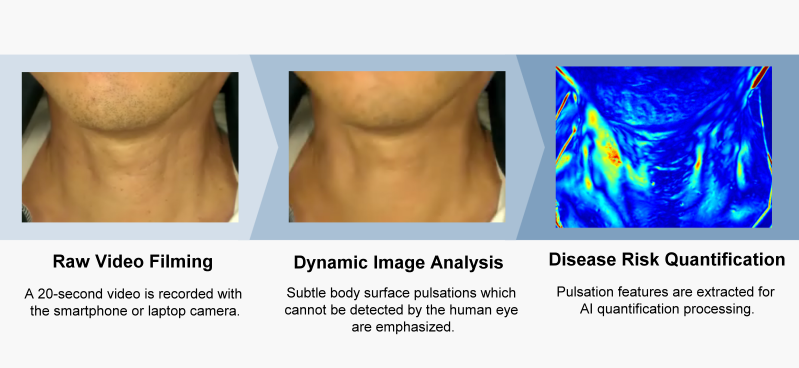NTU Develops World's First Rapid Imaging & Screening Technology for Stroke
Prof. Hao-Ming Hsiao from NTU's Dept. of Mechanical Engineering has cooperated with the team of Dr. Hsien-Li Kao, Director of the Cardiology Division of National Taiwan University Hospital (NTUH) for many years. Prof. Hsiao and Dr. Kao jointly developed an innovative imaging technology for carotid artery stenosis, which can be applied to rapid screening of stroke incidents. The research paper was published in the Journal of the American Heart Association in August 2022, and was reported by the Association in a feature article. In addition, the technology was also reported by more than 300 international news media and online platforms, such as the Associated Press, U.S. News & World Report, Daily Mail, San Francisco Chronicle (SFGATE), St. Louis Post, and other international mainstream media. Together, these reports generated more than one hundred million hits. The paper is also currently ranked in the top 5% of all papers according to the new citation impact indicator Altmetrics, demonstrating its significance in the academic circles.
Stroke (also known as cerebrovascular accident or brain attack) is one of the leading causes of death or severe disability worldwide, and it is estimated that stroke-related expenditures will reach a total of $36.7 billion worldwide in 2023. Among various symptoms, carotid artery stenosis is one of the early indicators of stroke. However, the current inspection methods, including MRA, CT, and carotid artery ultrasound, require large equipment and expensive costs. In addition, the equipment needs to be operated by professional medical personnel, who also have to interpret the images produced in person, rendering a high threshold of inspection. In response, the NTU team led by Prof. Hsiao successfully developed the world's first “Rapid Imaging & Screening Technology” for stroke, which uses dynamic image analysis to highlight subtle body surface pulsations which cannot be detected by the human eye, and captures such pulsation features for quantitative AI processing to alarm subjects suffering from a high risk of stroke. The inspection process is very user-friendly. The patient only needs a smartphone to take a video of their neck for 30 seconds. Then, the system will automatically upload the video to the cloud for analysis. The whole process only takes about three minutes, and the patient can immediately receive a risk assessment report, which can be compared with the results of carotid artery ultrasound examination in the hospital to achieve an accuracy of nearly 90%. This technology is efficient and accurate at an affordable price. It has no operating threshold and does not require professional medical workers to interpret the images. Thus, anyone who wishes to receive screening can have it done anytime, anywhere. The technology is expected to become the first line of rapid screening for stroke, or as a common practice of home medicine to facilitate early detection, further diagnosis, and treatment.
This innovative technology has won many awards, including three National Innovation Awards (2016, 2019, 2020), the 2020 Future Tech Award, first place of the 2021 X-Pitch Number Pitch Competition, and the 2016 US International Design Award (IDA). The technology also received the Ministry of Science and Technology’s 2019 Value Creation Program subsidies, which were used to develop this technology into a globally unique product. In 2020, the startup company Pulxion Medical Technology was established, and was shortlisted as one of the “Top Ten Startups in Taiwan 2021” by the Silicon-Valley-based tech magazine Startup City. The final product is scheduled to complete the TFDA certification in 2023 or 2024. After its launch, it is expected to benefit the general public and has great market potential. In the future, the team seeks to promote this technology to every community and family so as to achieve the goal of mobile and omnipresent healthcare.
Full text of the research paper can be accessed via https://www.ahajournals.org/doi/full/10.1161/JAHA.122.025702.
Coverage on other platforms or media can be accessed via the following hyperlinks: American Heart Association, U.S. News & World Report, Daily Mail (UK), and St. Louis Post.
